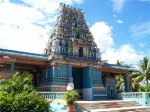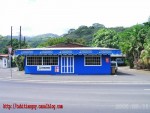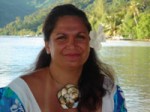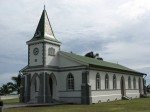A workshop “Asian Diasporas in the Pacific, history of representations and contemporary issues” (parts 1 & 2) hosted by the Asia-IMASIA network’s biannual conference took place in Paris on September 26th 2007. An opportunity to draw a first state of current research on these Asian Pacific communities, often considered in the Pacific islands as an ideal-type of “foreignness” symbolising wider evolutions such as economic globalisation, cultural and religious diversity, migration and urbanisation. Here are some outlines.
 The last report of the UNFPA (United Nations Found for Populations) in 2006 underlined the fact that Oceania has the largest concentration of immigrants in its population (15,2 per cent) of any region, mostly in New Zealand and Australia. Paola Voci, lecturer in Chinese language and cultures at the Otago University (Dunedin) sent us a communication on the Chinese community in New Zealand. According to the 2006 Census, 9.2 per cent of New Zealand population is now from Asian origin, 2/3 of it concentrated in Auckland area. The more numerous community are Chinese people – 147570 and a 40.5 per cent increase between 2001 and 2006. The other main groups are Indians (104583, +68.2 per cent) and Koreans (30792, +61.8 per cent).
The last report of the UNFPA (United Nations Found for Populations) in 2006 underlined the fact that Oceania has the largest concentration of immigrants in its population (15,2 per cent) of any region, mostly in New Zealand and Australia. Paola Voci, lecturer in Chinese language and cultures at the Otago University (Dunedin) sent us a communication on the Chinese community in New Zealand. According to the 2006 Census, 9.2 per cent of New Zealand population is now from Asian origin, 2/3 of it concentrated in Auckland area. The more numerous community are Chinese people – 147570 and a 40.5 per cent increase between 2001 and 2006. The other main groups are Indians (104583, +68.2 per cent) and Koreans (30792, +61.8 per cent).
The New Zealand migration policies explain for a large part the deep religious diversity that can be observed today: Buddhists, Hindus, Sikhs, but also Korean or Samoan churches, etc… a cultural patchwork combined with the diversity of Protestantism (see for example my post on August 16th 2006 on Brethren communities).
 In Fiji, as I wrote in last December, the several coups that occurred since 1987 are all related to the coexistence in this country – with a proportion close to 50/50 – of indigenous Fijians (“Ethnic Fijians”) and Fijians from Indian descent (“Indo-Fijians”), who were brought to Fiji at the end of the 19th century by the British colonial authority to work in the sugar cane plantations. The majority of them are Hindus, with about 15 per cent of Muslims and a small Christian minority.
In Fiji, as I wrote in last December, the several coups that occurred since 1987 are all related to the coexistence in this country – with a proportion close to 50/50 – of indigenous Fijians (“Ethnic Fijians”) and Fijians from Indian descent (“Indo-Fijians”), who were brought to Fiji at the end of the 19th century by the British colonial authority to work in the sugar cane plantations. The majority of them are Hindus, with about 15 per cent of Muslims and a small Christian minority.
Some Christian churches, like the Methodist Church which makes 36 per cent of the population (66 per cent of the Ethnic Fijians) today advocates a conception of Fijian identity based on the land (Indo-Fijians are not allowed to be land owners), traditions and Christianity. They promote the establishment of a Christian state that would lead to the exclusion of Indo-Fijians from the government. What they call “reconciliation” sometimes means nothing else than the conversion of Indo-Fijians to Christianity, considered as the only way to provide national unity.
The Pacific Chinese communities are often very active in commerce (in many islands of French Polynesia, “to go to the Chinese” means to go to the deli). They have been stigmatised for long by colonial (and sometimes religious) authorities or local populations, especially during economic crisis. In the interwar years, the French colonial milieu in Tahiti was particularly focused on the “Chinese peril” endangering a Polynesian people described as “primitive, naïve and infantile” by the Abbot Rougier. Unfortunately, similar reflections can still be heard sometimes in today conversations. The history of the Chinese in Tahiti has been presented in several publications and academic works, among the more recent ones: the book of B. Saura, Tinito (Au Vent des îles, 2002), Identité hakka à Tahiti by Ernest Sin Chan (Teite, 2005) – who participated in the workshop – and the Ph.D. dissertation of A.-C. Trémon, “Les Chinois en Polynésie française. Configuration d’un champ des identifications”, defended in 2005 at the EHESS.
endangering a Polynesian people described as “primitive, naïve and infantile” by the Abbot Rougier. Unfortunately, similar reflections can still be heard sometimes in today conversations. The history of the Chinese in Tahiti has been presented in several publications and academic works, among the more recent ones: the book of B. Saura, Tinito (Au Vent des îles, 2002), Identité hakka à Tahiti by Ernest Sin Chan (Teite, 2005) – who participated in the workshop – and the Ph.D. dissertation of A.-C. Trémon, “Les Chinois en Polynésie française. Configuration d’un champ des identifications”, defended in 2005 at the EHESS.
My own research on Pentecostalism in French Polynesia led me to analyse the circumstances of the rise of Pentecostalism within the hakka community of Tahiti, in the beginning of the 60s, and the establishment of the first Pentecostal church in French Polynesia, the Alleluia Church – a Chinese speaking church (see my article “Pentecostalism in French Polynesia, a hakka story”). The Catholic church has also established a Chinese parish in Tahiti, following the guidelines of Vatican II Council for a better understanding of local languages and cultures.
 In many Pacific islands, Chinese storekeepers have been targeted by riots linked to political tensions: during demonstrations against the Tongan government and for democratic reforms in November 2006 (see also my note of September 13th 2006), several Chinese shops were burnt in the centre of Nuku’alofa, the Capital city. In Honiara, the Capital city of Solomon Islands, several hundreds of Chinese storekeepers got in similar troubles in April 2006, as underlined by P. de Deckker in an article published in June 2007 (Tahiti Pacific magazine): they were accused to have financially supported the campaign of the newly elected Prime minister – who finally had to step down.
In many Pacific islands, Chinese storekeepers have been targeted by riots linked to political tensions: during demonstrations against the Tongan government and for democratic reforms in November 2006 (see also my note of September 13th 2006), several Chinese shops were burnt in the centre of Nuku’alofa, the Capital city. In Honiara, the Capital city of Solomon Islands, several hundreds of Chinese storekeepers got in similar troubles in April 2006, as underlined by P. de Deckker in an article published in June 2007 (Tahiti Pacific magazine): they were accused to have financially supported the campaign of the newly elected Prime minister – who finally had to step down.
Other Asian communities are less exposed and have not often attracted the interest of researchers. This workshop gave us the opportunity to hear about the Javanese community in New Caledonia with J.-L. Maurer (who has published in 2006 a book untitled “Les Javanais du caillou. Sociologie historique de la communauté indonésienne de Nouvelle-Calédonie, Maison des sciences de l’homme) and Dominique Jouve (who has studied the representations of New Caledonia Javanese and Vietnamese in literature). Virginie Riou also presented the journeys of Tonkin workers and they descendants in New Hebrides – Vanuatu – from 1920 until today.
Besides, the small Pacific states play a significant role in the relations between Western and Asian countries as well as in the competition between Taiwan and Continental China, who are both seeking their diplomatic support within the UNO Assembly. Fabrice Argounes (a Ph.D. student at Science Po Bordeaux), and Sarah Mohamed-Gaillard (INALCO) presented the historical, geopolitical and economic dimensions of these issues. According to P. de Deckker in the article quoted above, “Taiwan currently has the support of the Marshall islands, Kiribati, Palau, Tuvalu and the Solomon islands”. This represents 1/5 of its diplomatic supports, after having lost the support of Tonga (in 1998), Nauru (in 2002) and failed to get the support of Vanuatu (in 2004). A hard competition, in which financial help to fragile island economies play a major role.
* Illustrations: a celebration within the Chinese community in Auckland (New Zealand); Hindu temple in Nadi (Fiji); Chinese New Year at the Maria no te hau cathedral in Tahiti; Chinese store in Tahiti (this photo is part of a remarkable series that can be seen on the blog “Tahitian Guy”.
 The last report of the UNFPA (United Nations Found for Populations) in 2006 underlined the fact that Oceania has the largest concentration of immigrants in its population (15,2 per cent) of any region, mostly in New Zealand and Australia. Paola Voci, lecturer in Chinese language and cultures at the Otago University (Dunedin) sent us a communication on the Chinese community in New Zealand. According to the 2006 Census, 9.2 per cent of New Zealand population is now from Asian origin, 2/3 of it concentrated in Auckland area. The more numerous community are Chinese people – 147570 and a 40.5 per cent increase between 2001 and 2006. The other main groups are Indians (104583, +68.2 per cent) and Koreans (30792, +61.8 per cent).
The last report of the UNFPA (United Nations Found for Populations) in 2006 underlined the fact that Oceania has the largest concentration of immigrants in its population (15,2 per cent) of any region, mostly in New Zealand and Australia. Paola Voci, lecturer in Chinese language and cultures at the Otago University (Dunedin) sent us a communication on the Chinese community in New Zealand. According to the 2006 Census, 9.2 per cent of New Zealand population is now from Asian origin, 2/3 of it concentrated in Auckland area. The more numerous community are Chinese people – 147570 and a 40.5 per cent increase between 2001 and 2006. The other main groups are Indians (104583, +68.2 per cent) and Koreans (30792, +61.8 per cent).The New Zealand migration policies explain for a large part the deep religious diversity that can be observed today: Buddhists, Hindus, Sikhs, but also Korean or Samoan churches, etc… a cultural patchwork combined with the diversity of Protestantism (see for example my post on August 16th 2006 on Brethren communities).
 In Fiji, as I wrote in last December, the several coups that occurred since 1987 are all related to the coexistence in this country – with a proportion close to 50/50 – of indigenous Fijians (“Ethnic Fijians”) and Fijians from Indian descent (“Indo-Fijians”), who were brought to Fiji at the end of the 19th century by the British colonial authority to work in the sugar cane plantations. The majority of them are Hindus, with about 15 per cent of Muslims and a small Christian minority.
In Fiji, as I wrote in last December, the several coups that occurred since 1987 are all related to the coexistence in this country – with a proportion close to 50/50 – of indigenous Fijians (“Ethnic Fijians”) and Fijians from Indian descent (“Indo-Fijians”), who were brought to Fiji at the end of the 19th century by the British colonial authority to work in the sugar cane plantations. The majority of them are Hindus, with about 15 per cent of Muslims and a small Christian minority.Some Christian churches, like the Methodist Church which makes 36 per cent of the population (66 per cent of the Ethnic Fijians) today advocates a conception of Fijian identity based on the land (Indo-Fijians are not allowed to be land owners), traditions and Christianity. They promote the establishment of a Christian state that would lead to the exclusion of Indo-Fijians from the government. What they call “reconciliation” sometimes means nothing else than the conversion of Indo-Fijians to Christianity, considered as the only way to provide national unity.
The Pacific Chinese communities are often very active in commerce (in many islands of French Polynesia, “to go to the Chinese” means to go to the deli). They have been stigmatised for long by colonial (and sometimes religious) authorities or local populations, especially during economic crisis. In the interwar years, the French colonial milieu in Tahiti was particularly focused on the “Chinese peril”
 endangering a Polynesian people described as “primitive, naïve and infantile” by the Abbot Rougier. Unfortunately, similar reflections can still be heard sometimes in today conversations. The history of the Chinese in Tahiti has been presented in several publications and academic works, among the more recent ones: the book of B. Saura, Tinito (Au Vent des îles, 2002), Identité hakka à Tahiti by Ernest Sin Chan (Teite, 2005) – who participated in the workshop – and the Ph.D. dissertation of A.-C. Trémon, “Les Chinois en Polynésie française. Configuration d’un champ des identifications”, defended in 2005 at the EHESS.
endangering a Polynesian people described as “primitive, naïve and infantile” by the Abbot Rougier. Unfortunately, similar reflections can still be heard sometimes in today conversations. The history of the Chinese in Tahiti has been presented in several publications and academic works, among the more recent ones: the book of B. Saura, Tinito (Au Vent des îles, 2002), Identité hakka à Tahiti by Ernest Sin Chan (Teite, 2005) – who participated in the workshop – and the Ph.D. dissertation of A.-C. Trémon, “Les Chinois en Polynésie française. Configuration d’un champ des identifications”, defended in 2005 at the EHESS.My own research on Pentecostalism in French Polynesia led me to analyse the circumstances of the rise of Pentecostalism within the hakka community of Tahiti, in the beginning of the 60s, and the establishment of the first Pentecostal church in French Polynesia, the Alleluia Church – a Chinese speaking church (see my article “Pentecostalism in French Polynesia, a hakka story”). The Catholic church has also established a Chinese parish in Tahiti, following the guidelines of Vatican II Council for a better understanding of local languages and cultures.
 In many Pacific islands, Chinese storekeepers have been targeted by riots linked to political tensions: during demonstrations against the Tongan government and for democratic reforms in November 2006 (see also my note of September 13th 2006), several Chinese shops were burnt in the centre of Nuku’alofa, the Capital city. In Honiara, the Capital city of Solomon Islands, several hundreds of Chinese storekeepers got in similar troubles in April 2006, as underlined by P. de Deckker in an article published in June 2007 (Tahiti Pacific magazine): they were accused to have financially supported the campaign of the newly elected Prime minister – who finally had to step down.
In many Pacific islands, Chinese storekeepers have been targeted by riots linked to political tensions: during demonstrations against the Tongan government and for democratic reforms in November 2006 (see also my note of September 13th 2006), several Chinese shops were burnt in the centre of Nuku’alofa, the Capital city. In Honiara, the Capital city of Solomon Islands, several hundreds of Chinese storekeepers got in similar troubles in April 2006, as underlined by P. de Deckker in an article published in June 2007 (Tahiti Pacific magazine): they were accused to have financially supported the campaign of the newly elected Prime minister – who finally had to step down.Other Asian communities are less exposed and have not often attracted the interest of researchers. This workshop gave us the opportunity to hear about the Javanese community in New Caledonia with J.-L. Maurer (who has published in 2006 a book untitled “Les Javanais du caillou. Sociologie historique de la communauté indonésienne de Nouvelle-Calédonie, Maison des sciences de l’homme) and Dominique Jouve (who has studied the representations of New Caledonia Javanese and Vietnamese in literature). Virginie Riou also presented the journeys of Tonkin workers and they descendants in New Hebrides – Vanuatu – from 1920 until today.
Besides, the small Pacific states play a significant role in the relations between Western and Asian countries as well as in the competition between Taiwan and Continental China, who are both seeking their diplomatic support within the UNO Assembly. Fabrice Argounes (a Ph.D. student at Science Po Bordeaux), and Sarah Mohamed-Gaillard (INALCO) presented the historical, geopolitical and economic dimensions of these issues. According to P. de Deckker in the article quoted above, “Taiwan currently has the support of the Marshall islands, Kiribati, Palau, Tuvalu and the Solomon islands”. This represents 1/5 of its diplomatic supports, after having lost the support of Tonga (in 1998), Nauru (in 2002) and failed to get the support of Vanuatu (in 2004). A hard competition, in which financial help to fragile island economies play a major role.
* Illustrations: a celebration within the Chinese community in Auckland (New Zealand); Hindu temple in Nadi (Fiji); Chinese New Year at the Maria no te hau cathedral in Tahiti; Chinese store in Tahiti (this photo is part of a remarkable series that can be seen on the blog “Tahitian Guy”.
 Historien spécialiste de la vie politique polynésienne, Jean-Marc Regnault est notamment l’auteur d’un livre paru en 2004,
Historien spécialiste de la vie politique polynésienne, Jean-Marc Regnault est notamment l’auteur d’un livre paru en 2004,  rapprochement peut-être temporaire
rapprochement peut-être temporaire Q. La candidature de Ségolène Royal, qui a recueilli en Polynésie française des scores importants, a semblé y conforté l’idée que « l’heure des femmes » était peut-être venue.
Q. La candidature de Ségolène Royal, qui a recueilli en Polynésie française des scores importants, a semblé y conforté l’idée que « l’heure des femmes » était peut-être venue.  La croix représente davantage la souffrance que le Christ lui-même. La culture locale, l’histoire locale ne permettent pas de poser les termes du combat politique en termes de luttes de classes, d’oppositions sociales, pas davantage sous l’aspect de de l’affrontement droite/gauche. La culture commune aux Polynésiens étant le christianisme, seul le langage biblique permet aux gens de se repérer.
La croix représente davantage la souffrance que le Christ lui-même. La culture locale, l’histoire locale ne permettent pas de poser les termes du combat politique en termes de luttes de classes, d’oppositions sociales, pas davantage sous l’aspect de de l’affrontement droite/gauche. La culture commune aux Polynésiens étant le christianisme, seul le langage biblique permet aux gens de se repérer. L’Etat peut-il être impartial tant que les électeurs d’outre-mer peuvent faire ou défaire une élection nationale? Peut-il l’être tant que les dirigeants nationaux n’ont qu’une connaissance limitée des réalités de l’outre-mer? En Polynésie, il y a toujours eu un leader protégé par le gouvernement central et c’est au travers de lui que ce gouvernement entendait contrôler le Territoire. Nicolas Sarkozy n’a pas failli à la tradition et il a immédiatement pris le parti de G. Tong Sang sans chercher à connaître sa représentativité. Le défaut de l’autonomie, c’est d’avoir négligé l’aspect économique. Avec le temps, la dépendance économique et financière n’a fait que croître. Un gouvernement central peut asphyxier tout gouvernement local qui lui déplairait.
L’Etat peut-il être impartial tant que les électeurs d’outre-mer peuvent faire ou défaire une élection nationale? Peut-il l’être tant que les dirigeants nationaux n’ont qu’une connaissance limitée des réalités de l’outre-mer? En Polynésie, il y a toujours eu un leader protégé par le gouvernement central et c’est au travers de lui que ce gouvernement entendait contrôler le Territoire. Nicolas Sarkozy n’a pas failli à la tradition et il a immédiatement pris le parti de G. Tong Sang sans chercher à connaître sa représentativité. Le défaut de l’autonomie, c’est d’avoir négligé l’aspect économique. Avec le temps, la dépendance économique et financière n’a fait que croître. Un gouvernement central peut asphyxier tout gouvernement local qui lui déplairait. Etats-Unis et la première grande église a ouvert en 1906 rue Azusa à Los Angeles, sous l’impulsion du pasteur noir William J. Seymour. Son histoire est liée à celle du méthodisme, un Réveil protestant qui a eu lieu en Angleterre au cours des années 1730 et a nourri une grande partie de l’enthousiasme missionnaire du XVIIIe siècle – notamment dans le Pacifique : l’église wesleyenne de Tonga, par exemple, porte le nom du fondateur du méthodisme,
Etats-Unis et la première grande église a ouvert en 1906 rue Azusa à Los Angeles, sous l’impulsion du pasteur noir William J. Seymour. Son histoire est liée à celle du méthodisme, un Réveil protestant qui a eu lieu en Angleterre au cours des années 1730 et a nourri une grande partie de l’enthousiasme missionnaire du XVIIIe siècle – notamment dans le Pacifique : l’église wesleyenne de Tonga, par exemple, porte le nom du fondateur du méthodisme,  bouleversements de l’époque. Certains d’entre eux ont alors fait une expérience qu’ils ont interprétée comme une Pentecôte moderne : au cours de jeûnes et prières intenses, ils se sont mis à «parler en langues», dans un langage incompréhensible. C’est ce que les pentecôtistes appellent le «baptême du Saint-Esprit», parce qu’ils considèrent que c’est le Saint-Esprit qui, en descendant sur le croyant, lui inspire ces paroles et lui accorde un «revêtement de puissance», qui lui permettra de renouveler sa vie personnelle et de participer à la «grande mission» d’évangélisation.
bouleversements de l’époque. Certains d’entre eux ont alors fait une expérience qu’ils ont interprétée comme une Pentecôte moderne : au cours de jeûnes et prières intenses, ils se sont mis à «parler en langues», dans un langage incompréhensible. C’est ce que les pentecôtistes appellent le «baptême du Saint-Esprit», parce qu’ils considèrent que c’est le Saint-Esprit qui, en descendant sur le croyant, lui inspire ces paroles et lui accorde un «revêtement de puissance», qui lui permettra de renouveler sa vie personnelle et de participer à la «grande mission» d’évangélisation. Papara, 288 entre juillet 1962 et décembre 1963. Ce groupe est à l’origine de la paroisse de Jourdain (dont le nom a été choisi en référence aux baptêmes par immersion de 1962 et 1963), puis de l’église Alléluia, première église pentecôtiste polynésienne, née en 1967 d’une scission avec l’EEPF.
Papara, 288 entre juillet 1962 et décembre 1963. Ce groupe est à l’origine de la paroisse de Jourdain (dont le nom a été choisi en référence aux baptêmes par immersion de 1962 et 1963), puis de l’église Alléluia, première église pentecôtiste polynésienne, née en 1967 d’une scission avec l’EEPF. Quatrième raison d’être interpellée: la question du sacerdoce universel et de la formation. Avec l’élévation du niveau de scolarisation et de connaissance, beaucoup de Protestants polynésiens voudraient mieux connaître la Bible, en apprendre davantage sur la vie de Jésus, mais sans se retrouver dans un rapport trop hiérarchique de l’élève qui récite devant le maître. Faute de réponses satisfaisantes, ils se tournent vers les librairies (de Paofai, mais aussi les librairies pentecôtistes, adventistes ou catholiques), l’Internet, les cours par correspondance, les cassettes vidéo ou les stations de radio (combien de fidèles de l’EPM écoutent chaque matin Louis Levant sur RTV?). Les églises pentecôtistes répondent sans doute mieux à cette envie d’apprendre, ainsi qu’au désir de participer à la vie d’église, de prendre des responsabilités sans se trouver aussitôt accablé par le poids de la charge et la peur des critiques.
Quatrième raison d’être interpellée: la question du sacerdoce universel et de la formation. Avec l’élévation du niveau de scolarisation et de connaissance, beaucoup de Protestants polynésiens voudraient mieux connaître la Bible, en apprendre davantage sur la vie de Jésus, mais sans se retrouver dans un rapport trop hiérarchique de l’élève qui récite devant le maître. Faute de réponses satisfaisantes, ils se tournent vers les librairies (de Paofai, mais aussi les librairies pentecôtistes, adventistes ou catholiques), l’Internet, les cours par correspondance, les cassettes vidéo ou les stations de radio (combien de fidèles de l’EPM écoutent chaque matin Louis Levant sur RTV?). Les églises pentecôtistes répondent sans doute mieux à cette envie d’apprendre, ainsi qu’au désir de participer à la vie d’église, de prendre des responsabilités sans se trouver aussitôt accablé par le poids de la charge et la peur des critiques. transmis par les générations protestantes précé- dentes. En revanche, à l’exception des tendances les plus récentes (l’église du Plein Évangile notam- ment) ou de groupes influencés par Jeunesse en Mission, il ne fait pas preuve d’un militantisme culturel comparable à celui de l’EPM. Sans doute pour se distinguer de l’EPM, les assemblées de Dieu ont tendance à refuser ce qu’elles considèrent comme un repli sur soi et à offrir plutôt une ouverture sur l’extérieur qu’une valorisation de la culture locale. Elles insistent sur la nécessaire rupture avec la culture polynésienne pré-chrétienne, évoquent la lutte contre les esprits liés aux marae, aux tikis, et se montrent assez réticentes vis à vis d’expressions culturelles comme la danse. Les relations entre pentecôtisme et culture s’organisent donc sur la base d’une compréhension assez stricte de ce qui, dans la culture polynésienne, est compatible avec le christianisme.
transmis par les générations protestantes précé- dentes. En revanche, à l’exception des tendances les plus récentes (l’église du Plein Évangile notam- ment) ou de groupes influencés par Jeunesse en Mission, il ne fait pas preuve d’un militantisme culturel comparable à celui de l’EPM. Sans doute pour se distinguer de l’EPM, les assemblées de Dieu ont tendance à refuser ce qu’elles considèrent comme un repli sur soi et à offrir plutôt une ouverture sur l’extérieur qu’une valorisation de la culture locale. Elles insistent sur la nécessaire rupture avec la culture polynésienne pré-chrétienne, évoquent la lutte contre les esprits liés aux marae, aux tikis, et se montrent assez réticentes vis à vis d’expressions culturelles comme la danse. Les relations entre pentecôtisme et culture s’organisent donc sur la base d’une compréhension assez stricte de ce qui, dans la culture polynésienne, est compatible avec le christianisme.